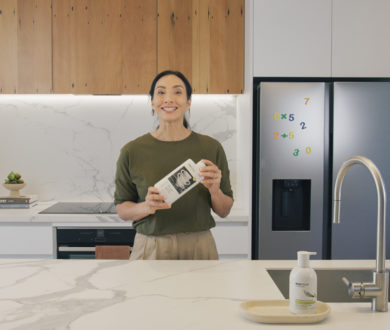As we prepare for a renewed social calendar full of smiles, we’re investigating the best teeth whitening processes to make a start on. To help us, Dental Hygienist Kate Rotella unpacks the latest teeth whitening innovations. After all, a smile is a curve that sets everything straight.
Whitening toothpaste
Toothpastes advertising a whitening effect often use abrasive ingredients to remove extrinsic staining, so your teeth feel shiny and polished. But be warned — over time they can wear down enamel and worsen colour. “The effects of using the wrong whitening agent or a really abrasive toothpaste will be long-term,” says Rotella. “Initially, you won’t see it but over a long period of time with micro wear and tear you will roughen those surfaces, then you get more staining anyway, so you’ve got to scrub harder. Then you’re going through the enamel and you’re going to start to see the yellow dentine underneath.” — If you’re still set on whitening toothpaste, Rotella recommends alternating with a standard, more gentle tube.
Whitening success rate: 1/10
Whitening toothpaste with a bleaching agent
Some whitening toothpastes have the benefit of the same bleach used in professional whitening — hydrogen peroxide — limited to a maximum of 3 percent. This can lighten the enamel underneath before you brush too much. But for whitening to work well, a peroxide has to be left on for a certain amount of time undisturbed — not a quick swish. “It’s a little bit debatable as to how effective it can be,” says Rotella.
Whitening success rate: 3/10
Charcoal toothpaste
A new generation of activated charcoal toothpastes is preferable as it is a lower abrasive in a pre-mixed solution. While it’s black when it goes on, there is another, unlikely benefit of using such a dark toothpaste. “A little bit of residue on the teeth creates a blue filter, which gives the illusion of whiter teeth,” explains Rotella.
Whitening success rate: 3/10
Blue light kits
One of the newest offerings is whitening kits that include the pre-requisite gel and teeth moulds with a built-in LED. The latter is supposed to speed up the process, but because these are not from a dental authority they will only have up to 6 percent hydrogen peroxide — which is New Zealand’s legal limit for off-the-shelf products. In theory, the blue light activates the molecules of the hydrogen peroxide so it works quicker — or it could be a marketing gimmick. “When you look at the research it’s negligible how much it actually makes a difference,” says Rotella. The most important thing in an at-home kit is the formula, which needs an aforementioned bleaching agent and plenty of water. Don’t buy whatever brand you find online, as they likely won’t have the right formula. “A lot of them will work well, but it’s because they’re dehydrating,” says Rotella. “It will create really bright white teeth in the first instance, but you may have extreme sensitivity and you won’t have any good long-term results with it.” The effects of such formulas will fade, and you’ll have to go through more discomfort to get back to the same shade of white. Instead, Rotella recommends sticking to reputable brands, such as Pola, White Blanc, Smile Pro and Zoom, which will ensure your teeth get the hydration and minerals they need.
Whitening success rate: 6/10
Whitening strips
Also bought off-the-shelf, whitening strips are stuck on the visible smile line of your teeth for a quick touch-up. After your teeth have been washed and dried, which can be done with cotton wool or tissues, they are left on from 30 to 45 minutes. The strips will still have up to 6 percent of active bleaching ingredients, but they are less messy. If you have never whitened before, you can do the full set for consecutive days — but don’t expect drastic results. For those who have had professional whitening, they can be useful for top-ups instead.
Whitening success rate: 5/10
Whitening pen
To help with long-term maintenance, there is also the option of a whitening pen which paints peroxide onto your teeth. The solution in the pen is sticky to stay on, but it can still come off without a shield over it. “It’s a bit like whitening toothpaste, it may have a tiny effect,” says Rotella. “It’s good for maintenance but I would never recommend something like that for someone who hasn’t done any [professional whitening].”
Whitening success rate: 5/10
Dental-grade, ready-to-go trays
Dental-grade, take-home trays offer higher levels of hydrogen peroxide, such as 10 or 15 percent, so they only need to be worn for 15-30 minutes. As you will be using these at your place, you see how your teeth are responding, and make an educated guess on how white you’d like to go. Quick and effortless, pre-done trays often come with desensitising agents within their formula. However, you still need to be careful when using a standard sized tray as the gel can spill over, which not only loses product but can have harmful consequences. “If you do it wrong, you can have chemical burn on the gums and cheeks. It’s only temporary but it’s very painful,” says Rotella.
Whitening success rate: 8/10
Custom whitening trays
A more tailored approach is having professional impressions taken for comfortable fitted trays. “The trays are custom-made perfectly so that you avoid contact with the gel,” says Rotella. Hydrogen or carbamide peroxide is carefully inserted at home with tailored syringe solutions — the strength of which will depend on the patient’s sensitivity, and personal preferences. “When you’re using the higher percentage, that’s when you need the guidance of a professional that you’re delivering it in the correct way for the right amount of time,” says Rotella. (Depending on the type and strength of the bleach, some will wear trays for 40-minutes a day, others will wear them overnight.) All teeth have an end whitening point, but most can be whitened several shades, to the natural colour before the enamel stained.
Whitening success rate: 9/10
In-house teeth whitening
If you have your teeth whitened in the dental chair, a much higher percentage of hydrogen peroxide — 25-35 percent — can be used at once in the controlled environment. After the teeth are isolated, and the rest of the mouth protected, the gel is applied and refreshed three times, and enhanced with a professional-strength blue light. If certain teeth need more whitening than others, then special attention can be given to these areas. Afterwards, there may be some sensitivity, and it’s recommended to stay away from hot and cold drinks for the next 24 hours. As you continue to live your life, and enjoy tannin-rich coffee, tea or red wine, staining will come back. Most professionals will also take impressions for maintenance trays as part of a complete package. “What you want to do is get yourself into a routine,” says Rotella. “I use my trays once a month for 15 minutes.” While your teeth will look wonderful for three to five years after a professional whitening, taking a shine to self-improvement will keep you smiling for many years to come.
Whitening success rate: 9.5/10
A note on sensitivity:
A whitening agent works by entering the enamel tubules of a tooth to break down the carbon molecules that have bunched together and created a darker appearance. Right in the middle of the tooth, where all this activity is happening, is the nerve — so it’s no wonder it can feel sore. “The reality is, I don’t think you can whiten your teeth without some sensitive reaction,” says Rotella. To help protect the nerve, most companies provide their own soothing relief gel from the outset. “There’s always ways to manage that sensitivity,” she reassures. “It should never be something that you worry about.”







